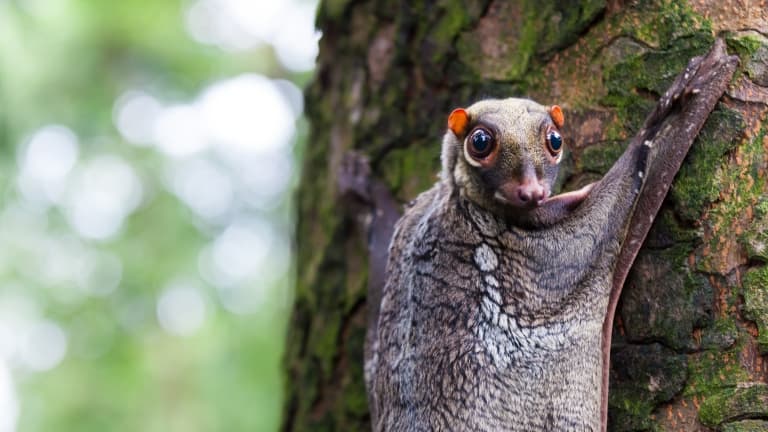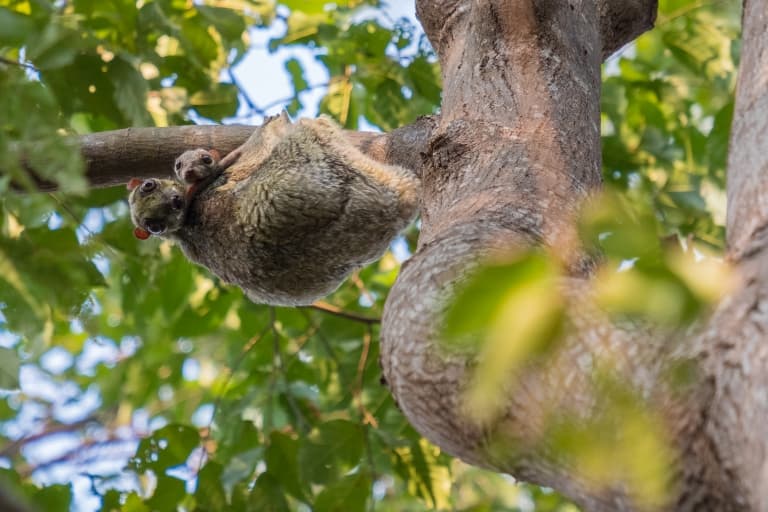Colugo Profile
The flying lemur, or colugo, is a tree-dwelling gliding mammal found in South East Asia. While they are known as flying lemurs, they are not actually lemurs, and they also can’t fly, but instead glide.
There are two species of them, the Sunda flying lemur (Galeopterus variegatus) and the Philippine flying lemur (Cynocephalus volans).

Colugo Facts Overview
| Habitat: | Rainforests |
| Location: | Southeast Asia |
| Lifespan: | 15 years in captivity, unknown in the wild. |
| Size: | 35-40 cm |
| Weight: | 1-2kg |
| Color: | Mottled grey, sometimes reddish |
| Diet: | Leaves, shoots, flowers, sap, and fruit |
| Predators: | Philippine Monkey-eating eagle, pythons, long-tailed macaques, and owls |
| Top Speed: | Unknown |
| No. of Species: |
2 |
| Conservation Status: |
Least concern |
The Sunda flying lemur is found in the broader area of South East Asia (e.g. Thailand and Malaysia) while the Philippine flying lemur, as its name suggests, is found only in the Philippines.
They are well known for being one of the best gliders, with a large membrane connecting all four limbs and their tail which allows them to “fly” for up to 200 meters between trees.
They are nocturnal, meaning they only come out at night. They are herbivores, consuming leaves, flowers, shoots, and fruit. They are solitary and shy, meaning not much is known about their behaviour.
Interesting Colugo Facts
1. They are not lemurs
While they may look like Lemurs, they are not. However, they are closely related to both primates and tree shrews. 1
2. They don’t fly, they glide
The only mammal which can independently fly is the bat. Instead, colugas glide which works in the same way as a wingsuit.
3. They are the best adapted of all the gliders
There are several gliding mammals, but of all of these, the Colugo is the best at gliding. They achieve this via the fury membrane connecting their limbs and their tail, making one big sail-like shape. 2
4. Their “wingspan” is 30-40cm
While they don’t actually have wings, the membrane (called the patagium) they use to glide spans 30 to 40cm when extended. This is one of the biggest amongst gliding mammals.
5. They have webbed feet
This is the same as bats and helps them fly.

6. They have a very light skeleton
Their skeleton is lighter than that of a squirrel, which helps them to glide for long distances.
7. No one is quite sure why they evolved to glide
Scientists thought that they evolved to glide as it saved energy, this however doesn’t seem to be the case. This suggests that there must be another reason. 3
8. They have comb-like teeth
Their teeth look like a tiny comb. These are excellent at slicing through leaves for food.
9. They raise their young like marsupials
While they are mammals, they look after their young in a pouch like marsupials do. Their mother creates a pouch using her flying membranes which the baby stays in for the first 6 months.
10. Baby Colugos are just 35g when they are born
This is tiny!

11. They have excellent eyesight
As they are nocturnal, they have to be able to see well at night. This is what gives them their large, adorable eyes.
12. The Philippine eagle eats them almost exclusively
This eagle is focused specifically on hunting the Philippine colugo, which makes up 90% of its diet. This eagle is at risk of extinction, making the colugo important for its continued survival.
13. They can be found in coconut, banana, and rubber plantations
As agriculture has moved into their habitat, they have started to move away from intact rainforests and into plantations.
14. Both are at risk from habitat destruction
The Philippine Colugo was taken off the endangered species list in 2008, however both species still struggle with habitat loss.
Colugo Fact-File Summary
Scientific Classification
| Kingdom: | Animalia |
| Phylum: | Chordata |
| Class: | Mammalia |
| Super Order: | Euarchontoglires |
| Order: | Dermoptera |
| Family: | Cynocephalidae |
Fact Sources & References
- Martin RD. Colugos: Obscure mammals glide into the evolutionary limelight. J Biol. 2008;7(4):13. doi:10.1186/jbiol74
- Byrnes G, Lim NTL, Spence AJ. Take-off and landing kinetics of a free-ranging gliding mammal, the Malayan colugo (Galeopterus variegatus). Proc R Soc B Biol Sci. 2008;275(1638):1007-1013. doi:10.1098/rspb.2007.1684
- Byrnes G, Libby T, Lim NTL, Spence AJ. Gliding saves time but not energy in Malayan colugos. J Exp Biol. 2011;214(16):2690-2696. doi:10.1242/jeb.052993
